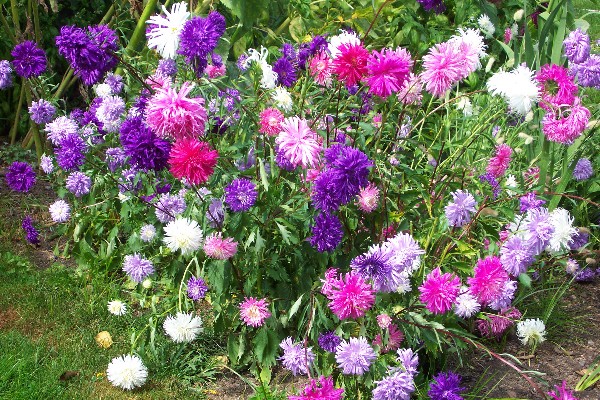Flower of the Month- September
Posted by from the Gardener's Network on 13th Aug 2021
Flower of the Month for September
How to Grow and Care for Aster Flowers

Perennial
Growing Asters is easy. Perennial Aster flowers grow well in average soils, but needs full sun. Blooms are 2 inches in diameter, and are wilt resistant. Aster flowers come in blues, purples and a variety of pinks. All Asters are yellow in the center of the flower. They are daisy-like in appearance, even though they are a member of the sunflower family.
Did you know? The yellow center of Asters is actually comprised of many tiny flowerets.
Asters come in a wide variety, with some less than a foot tall, while others are two feet tall or more. Both large and smaller varieties make good cut flowers for vases and arrangements.
Plant Height: up to 24 inches
Flowers Bloom: Summer/Fall
Plant Propagation:
Asters are easily grown from division. Aster plants do best, if divided every two to three years. Simply dig out half to two thirds of the plants, leaving the remainder in place. Then separate the portion you dug out into two sections and plant in another location or give them to a friend.
Aster seeds can also be directly seeded into your flower garden, or seeded indoors for transplanting later. We recommend planting Asters in pots and containers indoors, then transplanting the seedlings outdoors in early spring. This allows you to make the proper spacing.
Sow Aster seeds early in the season, and cover lightly with soil. Water thoroughly once. The seeds germinate easily and plants grow quickly, producing their first of a continual display of blooms by mid-summer.
Transplant Asters into your garden into an area where they can be grown for years. Spacing depends upon size with miniature varieties spaced four to six inches apart, and Giant varieties one to two feet apart. Place smaller varieties around the front of your flower garden as a border. Put larger varieties towards the back of the flowerbed.
Seed Germination: 8 - 10 days
How to Grow and Care for Asters:

Aster plants will grow well in average soils. But, like all plants, they will reward your with bigger blooms and a healthier plant if you add plenty of compost. Also, add a general purpose fertilizer once a month.
Once your Aster are established, they should grow well for years. Soil should be moist, but not wet. They will withstand dry periods. Water them during dry periods, once or twice per week to keep growth vibrant.
Add mulch around the plants for appearance and to keep weeds down.
Around mid to late summer, your plants will begin to produce flowers and will continue to do so until frost. You do not need to remove dead flower blooms, except to improve plant appearance. For giant varieties, trim back any stalks that have become gangly in appearance.
Cuttings for Indoors:
Asters have sturdy stalks that make them good candidates for flower vases and other arrangements. Cut the stem low, check for insects hiding in the flower, on the stem and under the leaves. Bring them indoors and place in water immediately.
For smaller varieties, use a small container or vase and cut stem a couple inches long. Bunch up a variety of colors for an eye-appealing arrangement. Add a small sprig or two of Baby's Breath.
Remember Asters, when creating container gardens for your deck or porch. They are excellent candidates.
Insect and Disease:
Asters are somewhat resistant to insects and disease. If insect or disease problems occur, treat early with organic or chemical insect repellents and fungicide.
